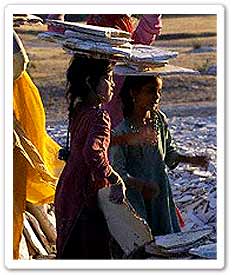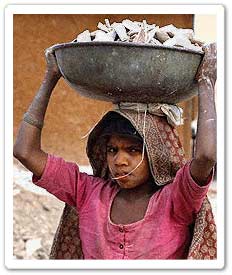 We fight for our rights at home for almost everything from late nights to going out of station with friends. We chat about human rights with our parents, teachers and friends. But have we ever thought about the children who are forced to work and do not even have basic rights?
We fight for our rights at home for almost everything from late nights to going out of station with friends. We chat about human rights with our parents, teachers and friends. But have we ever thought about the children who are forced to work and do not even have basic rights?India has the largest number of children employed than any other country in the world. According to the statistics provided by The Government of India around 90 million out of 179 million children in the six to 14 age group do not go to school and are engaged in some occupation or other. This means that close to 50 per cent of children are deprived of their right to a free and happy childhood.
Unofficially, this figure exceeds 100 million but the fact that a large number of these children work without wages in fields or in cottages alongside their parents, unreported by census, makes it very difficult to estimate accurately. However, it is estimated that if these working children constituted a country, it would be the 11th largest country in the world.
A large number of children work in cottage industries producing carpets, matches, firecrackers, bidis, brassware, diamond, glass, hosiery, hand loomed cloth, embroidery, leather goods, plastic, bangles and sporting goods. The highest number of children are found working in the agricultural sector.
Poverty has often been cited as the reason for the child labour problem in India. While it is true that the poorest, most disadvantaged sectors of Indian society suply the vast majority of child labourers, child labour actually creates an perpetuates poverty as it displaces adults from their jobs and also condemns the child to a life of unskilled badly paid work.
Merely passing laws is obviously not the solution, as they need to be enforced, in which our country has a poor track record. What are the causes for child labour? One can attribute it to various factors -- unemployment, low wages, poor standards of living, ignorance and illiteracy, social attitudes, and the like. Together they culminate in poverty and exploitation. The poor would rather have children who work to supplement the income. There are many cases where the parents sell their children as bonded labour for a petty sum of money. Banning child labour therefore is not the solution, nor is the step by the U.S. and Europe to ban carpets from India.
Ignorance is one of the main problems; ignorance on the part of the parents who believe that with the children working, poverty will be eradicated; and ignorance on the part of the children who do not know their rights in this country. The working conditions of the children are inhuman and the incomes given are also meagre. Eighty per cent of the children work in hazardous conditions.
At present, the legislations in India only specifically outlaw child labour in designated hazardous industries and bonded child labour, but both Article 24 of the Indian Constitution and Section 67 of the Factories Act explicitly direct that children below the age of 14 years are not to work in factories. In addition, the Child Labour (Prohibition and Regulation) Act 1986 forbids the employment of children in specified hazardous industries.
The Supreme Court ruling of December 10, 1996, in an attempt to fill the loopholes left in previous legislation and to bring in judicial activism to social issues ordered the setting up of a fund for the child workers aimed at controlling and eventually eliminating child labour across the length and breadth of the entire country. While setting out a long list of child labour monitoring obligations of the State Governments, it also prescribes heavy fines for employers caught with children at work. In addition, India has ratified the UN Convention on the Rights of the Child.

Laws pertaining to Child Labour:
- Children [Pledging of Labour] Act (1933)
- Employment of Children Act (1938)
- The Bombay Shop and Establishments Act (1948)
- Child Labour -Prohibition and Regulation Act
- The Indian Factories Act (1948)
- Plantations Labour Act (1951)
- The Mines Act (1952)
- Merchant Shipping Act (1958)
- The Apprentice Act (1961)
- The Motor Transport Workers Act (1961)
- The Atomic Energy Act (1962)
- Bidi and Cigar Workers (Condition of Employment) Act (1966)
- State Shops and Establishments Act
No comments:
Post a Comment
Thank you for your comments.
Regards,
Soham Foundation
"A child is a gift of God"